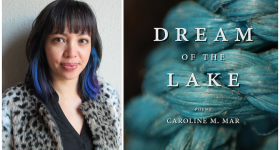White Dancing Elephants by Chaya Bhuvaneswar, winner of the Dzanc Books Short Story Collection Prize, is a book about crossing lines. The title story in the collection begins with a woman walking through London grieving her miscarried child, addressing a ghost in second person. By the middle of the story, however, the reader begins to suspect that the woman is a ghost as well, as Bhuvaneswar dances on the line between the real and surreal. “Talinda,” my favorite story in the collection, is about a woman who crosses one of the ultimate lines, sleeping with the husband of a close friend who also happens to be terminally ill. A collection of stories published in other venues such as Michigan Quarterly Review, Narrative Magazine, Story South and Asian American Literary Review, White Dancing Elephants is wide-ranging in terms of time and place. It travels from London to Bhopal to Boston, from Buddha’s birth to Renaissance Portugal to modern times — while seamlessly blending the real with the mythological, queer stories with cishet ones and immigrant stories with tales from the Indian diaspora. Bhuvaneswar’s debut is a promising one.
Note: This interview was conducted over email and has been edited and condensed for clarity.
Tell me about this book’s journey to publication. Was it agented and then submitted to the big houses?
I think these kinds of “behind the curtain” questions are fantastic, because so many writers, editors and agents helped me and I am now looking for ways to share what I learned. Like my wonderful colleague Vanessa Hua (Deceit and Other Possibilities) and also my fellow Sewanee Writers Conference participant, the PEN/Faulkner-nominated Venita Blackburn, as well as the super brilliant Amina Gautier, who just won the PEN/Malamud prize for her work in short stories — like all of these incredibly talented women of color, I did not have an agent. I did not submit my collection to any Big Five houses. I just entered a contest and was blessed enough to win. This is also similar to my beautiful, incandescent colleague Nana Kwame Adjei-Brenyah, whose big break was winning the Breakwater Review contest judged by ZZ Packer. I want to spotlight these contests (whether it’s the Dzanc Short Story Collection contest, which was also won by Laura van den Berg for her debut collection, or the Prairie Schooner prize, or the Flannery O’Connor Short Story Collection prize, which not only the incredible Amina won, but also Dana Johnson, for Break Any Woman Down, which like all our collections, looks deeply at race, sex, class, violence. Edwidge Danticat didn’t have an agent either. Her first book was a direct submission to an indie press. For some writers these contests can be a point of entry to getting an agent (as I did). But I just want to point to the ray of hope that is indie publishing for writers of color, particularly women of color and queer women of color.
My favorite story is “Talinda”, which is about a friendship between two women: Talinda, who’s dying of cancer and Narika, who’s sleeping with and pregnant with the child of Talinda’s husband. It’s so fraught and complicated. Narika has crossed so many moral lines you lose count, but there’s a tenderness between the two women that seems non-negotiable. How did this story originate?
In Flushing, I had a childhood friend who always lent me money to buy a hot dog from the stand right outside the acupuncturist in that side street opposite the big parking lot, soon after you leave the Main Street subway station. I wrote many stories about this friend. I know at some point I must have been in love with her. This particular story spilled out one day when I was reading Susan Sontag, soon after I had my first child and realized how lonely it felt not to have this friend in my life anymore, because she’d abruptly “ghosted” me soon after I finished med school. Imagining her really gone, gone from the world, I felt enormous grief.
So many times in stories, you see adultery portrayed as a result of lust, as a careless decision, but in “Talinda”, it’s a deeply considered choice by both parties. In a few of the other stories, adultery is portrayed as similarly more complicated (and less selfish, one might argue) than adultery is portrayed in most classic short fiction. Why was it important for you to perhaps soften the stigma around what is traditionally considered “bad behavior”?
I don’t know that I believe in the concept of “bad behavior” except for cases of actual physical violence, or class, gender and sexual orientation-based discrimination — what the GOP is trying to do by nominating someone who might be a rapist to the Supreme Court. I mean, “adultery” presupposes a kind of “ownership” that I’m too feminist and queer to really believe in; yet at the same time, I love giving my children the security of fidelity to my partner, their father. But I guess I’ve always felt there to be a tremendous difference between what I feel the happiest doing/what I want my own partner to be like versus what I would prescribe for anyone else. I don’t judge unless somebody’s getting traumatized, or somebody’s childhood and stability could be destroyed. I don’t think I could have written “Talinda” as a story where the title character had children and her best friend was simply willing to step all over them to get the children’s father, somebody else’s husband, in bed. I wouldn’t have been interested in that; it’s too harmful and needless. One essay about “infidelity” I really love is by Jaishri Abichandani, the fabulous South Asian American artist and sculptor who founded the South Asian Women’s Creative Collective two decades ago. Readers of Hyphen might be familiar with that, and with her various exhibits with amazing artists like Shahzia Sikander, but Jaishri also wrote an incredible work at Ms. about her uncle’s affair with a woman and her own affair with a married college professor, looking at both from a feminist standpoint. Yet I remember showing this article to a good Sri Lankan-American cishet male friend of mine, someone I love like a brother, and inciting his abiding disgust with these ideas. He adamantly opposed the idea that any affair could ever be, in any sense, acceptable, and my tolerance actually made him worry about me! (Hey Shamal, if you’re reading this — all good). In a story, any kind of story, the most important thing to me is the emotion of the character, the journey of that character. I often get interested in how the underlying emotion turns out to be so different than how that character herself would describe her own motivation. Like, Narika might view herself as “disloyal” and “bad,” but the overriding emotion that drives her is a choking loyalty to Talinda, a fascination with her, a sense of belonging to her that goes so deep it includes having a child with (the white) man Talinda loves.
I really appreciated “A Shaker Chair”, which addresses class enmity and racial self-hatred. Sylvia, a mixed-race psychologist, treats a young and troubled Indian woman, and from the opening lines, the reader can tell something is off about Sylvia. (“At least the girl was never late, thought Sylvia. Like most Indians Sylvia had ever known — actually most Asians in general — this girl Maya, this 20-year-old patient who was over two decades younger than Sylvia, was conscientious, consistent.”) It’s a story that isn’t told enough — the way people of color, in this case women of color, target each other within an American societal construct that is white-dominated, wealth-obsessed and patriarchal. The epigraph in the book is from a Seamus Heaney poem about “tribal, intimate revenge.” Why did you choose to tell a story like “A Shaker Chair”, which, like “Talinda”, is about a sort of psychological violence between two women who are, in essence, members of the same tribe?
This story was actually inspired by a famous African American psychoanalyst who in a public lecture made a very problematic, reductive comment about South Asians and other Asian Americans that completely rocked my world. It was of a piece with the fact that a Latino boy stands accused of beating a Pakistani teenager to death, as I write about here: https://sites.lsa.umich.edu/mqr/2017/08/safe/. Some groups of African Americans made racist and exclusionary and outright hateful statements about South Asians and Middle Easterners after 9/11, even though my white neighbors in Queens, NY, targeted all of us, all people of color, living in what these whites considered “their” neighborhoods. And we know from the 1990s how much enmity there has been between Asian Americans and other people of color in Los Angeles, how the L.A. riots exposed such deep and wounding rifts. One thing that was important to me: I was going to write what felt true. What can hurt us even more than rejection, betrayal, or “non-seeing” by fellow Americans who don’t identify as people of color? The various, nearly infinite ways in which we, of the diasporic tribes, can disappoint each other. But honesty can maybe form part of our healing.
“Neela: Bhopal” is set around the world’s deadliest industrial accident in modern history, when poison gas leaked from a Union Carbide plant in 1984 and killed tens of thousands of people and affected over a half million people. That last line is a scathing indictment of the dark side of the global economy that’s only become more prevalent since the time of the story: “All this was caused by someone important, an American, used to ordering some work finished somewhere else, the back of his head under a beam of light from a window that has been opened on a summer day, allowing the Houston air into the office for a few seconds before the air conditioning goes full blast.” Why did you choose the second-person point of view for this piece and what advantages do you think it provides in terms of storytelling?
I feel like this story really found me rather than me choosing it. In this case because the editor of Narrative Northeast, the wonderful poet Pamela Hughes rejected one of my pieces and asked if I had another story on the theme of environmental destruction. I thought of Bhopal, as I have on and off since I passed through the city while taking a train to the other town in Madhya Pradhesh, “middle India”, where many of my relatives live. I remember seeing that sign and peering from the train window, expecting to find more than I did, wondering why God had made it so that the people I loved didn’t live near enough to Bhopal to have been affected. I love the second person, sparingly. One of my favorite writers who really transports the reader into inhabiting the main character of the story he’s telling, who really makes you feel like his protagonist, is Italo Calvino, in If On a Winter’s Night, a Traveler. I think it really works when you can’t tell the story using any other voice, when you want to highlight tone in a particular way, and when there’s some urgency you feel (notice I am using the second person even now — see how that works?) about communicating not so much specific information (for which third omniscient is pretty fantastic). With the second person, you create a tense, immediate, hopefully gripping identification between the character being addressed as “you”, and the “you” who is the reader. I think the second person is also so amazingly important in poetry. There are doubtless many beautiful contemporary examples, more than I can think of right now, but the medieval Hindu bhakti, or devotional poetry, uses the second person and it makes the reader feel so included in the swell of emotion. It makes the listener/reader feel seen. To me it was also important that the child, that Neela in the story, be seen, in a way that history hasn’t seen her at all, nor millions of other children who remain so vulnerable.
“Asha in Allston” dips into the future (or the present, depending on your point of view). There’s a very human reckoning with degenerative illness and mortality, and then there’s the sex robot. There’s something almost Black Mirror-ish about the story. What inspired you to blend the humanistic with the technological?
Both Margaret Atwood and George Saunders have really inspired me in this — especially Saunders in Tenth of December, blending these intimately human portraits and interior landscapes with something so cold, metallic, inhuman, drawn from various exaggerations of existing technology. Margaret Atwood is so important as a writer who’s always been able to ask and imagine, “How far could they go?” about any kind of oppressors, about any kind of future involving oppressive technologies. I also pretty much adore Jeff VanderMeer in this regard, so that was a huge and unexpected thrill, having him read and even blurb this collection, along with Kelly Link being in touch once we realized I was in the same studio at the MacDowell Colony, where she’d been a few years before. She also writes about these themes with such an empathic, genuinely curious, knowing gaze.
What are you working on next?
I’m grateful to say that we are about to send a novel on submission, and in addition there is an essay collection I’ve been working on, with pieces that have appeared in Luna Luna, The Millions, Tin House online, one pending in Longreads, and elsewhere. There’s also a linked story collection from which sections have been published in Joyland and Narrative and I’m kind of hopeful and excited about how that collection will follow the journeys of an interracial couple, from Obama’s America, into our unknown future.










Comments